RMAF's Sukhois to arrive in May — one year late
-
One thing obviously forget to mention here is the AWACS, in a system vs system air combat, with or without this important asset really makes the qualitative difference.
1. The narrow angeled cone view of fighterÂ’s fire control radar is really no way to compare to the 360 degree view of the Airborne early warning machines like E-2C or G550 AEWS. If one side is with AEWS yet another side doesnÂ’t have it. The AEWs guided fighters are able to silently venture behind the hostile fighters by avoiding entering the cone view of the hostile fighter thus prevent from being detected. Once you achieve the position by guidance from AEWS, but for the side without the AEWS, it has to rely on its fire control radar doing all the search and broadcasting all the way of its about.
2. In a system vs system air combat. 1 fighter is not only bonded to fight one enemy fighter. But it has to face all, thatÂ’s even you have made an excellent big turn by TVC or not, you may only out maneuver fighter A from the enemy fleet you aimed at, but to the enemy fighter B in the same fleet, the maneuvered fighter, which loses too much energy in order to gain superior position over enemy fighter A, is just a sitting duck because it ha already lost too much speed in order to achieve the big turn. So, if in a multiple fighters air combat, maintaining the overall energy state of the whole fleet is more important than the individual fighterÂ’s super-maneuverability. Even in a close in fight. -
Correct, thats why I only mentioned AMRAAM-Bs, not the C-4, C-5 or even C-7s.Originally posted by DingChavez:funny you should mention this, i was just reading about it. the newer amraams have a two stage booster, the first is a high impulse booster to accelerate the missile to mach 4+ and the second stage is a lower impulse for to sustain the missile. looks like the newer amraams is even more lethal ( not that the old ones aren't)
within the current 4+ gen aircraft, your second statement is correct.
The later models have capabilities for sustained boost. BUT they do that a the cost of reduced maximum range. They burn more fuel for sustained burns. Hence, lofting AMRAAMs are still the most energy efficient and can make the most out of its range. (IIRC one of the C models some how makes up for it and maintains equal range of with the B.)
Typically, they are best launched at high altitudes and at high sub-sonic speeds. In that arena, it can really reach out and touch things. -
off topic...IAF just send over MKI to UK for exercise and participate ine the recent airshow there.....this photo left me in awwww...


-
I'd like to see the results of a Typhoon vs MKI clash if there was one.
Supposedly, the Typhoon was boasted to be able to handle 4- Sukhoi-35s. And supposedly 2nd only to the Raptor. -



model -
Some news of Su-30 - Typhoon Guns duel over Ex Indradhanush.
http://pib.nic.in/release/release.asp?relid=29045
The Indian Public information Bureau report suggests a draw, despite sending slightly greener pilots. -
offtopic also...in recent jul AFM, there is a rare photo of Indian Su-30MKI in formation with our RSAF F-16C/D ...i have yet the scan the photo yet
-
Sukhoi's PAKFA design remains uncertain,09 July 2007
The final shape and design of Sukhoi�s fifth-generation fighter aircraft remains unclear despite media reports to the contrary and even information released by engine design authority Saturn NPO.
The PAKFA (Perspektivnnyi Aviatsionnyi Kompleks Frontovoi Aviatsyi, or Future Air Complex for Tactical Air Forces) is a middle-weight twin-engine fighter that will be a larger aircraft than the Russian Aircraft Corporation MiG MiG-29 and smaller than the Sukhoi Su-27, but will replace both types.
It will be close to the weight class and overall wing area of the Lockheed Martin F-35 Joint Strike Fighter but, unlike its fully multirole US counterpart, its primary mission will be as an air-superiority fighter and interceptor. However, it will still have some multirole capability with air-to-ground and electronic intelligence/reconnaissance mission capabilities.
126 of 379 words
© 2007 Jane's Information Group
-
the american were reviving the F15 S / MTD to study on how to defeat TVC ac! can anyone confirm this?
-
Found an article about our neighbour:
Copyrighted from : http://en.rian.ru/analysis/20070718/69174039.html
MOSCOW. (Yury Zaitsev for RIA Novosti) - Malaysia will receive the first 12 of its order of 18 Sukhoi Su-30-MKM Flanker fighters, the most advanced versions of the Su-27 warplane, before the year is out. The Su-30-MKM embodies the best achievements of the Russian aircraft industry and has the most advanced European avionics.
The Malaysian version is based on the Su-30-MKI, earmarked for India, but features different equipment and an electric remote control system.
Unlike the Indian version, the Su-30-MKM features a laser warning system and missile detectors. Two Russian-made active jamming systems are located inside wing-tip containers, and the fighter also has passive jamming systems featuring dipole reflectors and 98 decoys against heat-seeking missiles in the tail section.
The Malaysian version has more Russian-made components than the Su-30-MKI because Indian and Israeli systems have been removed from it. However, the Su-30-MKM features additional French-made systems.
Russia's Bars (Snow Leopard) phased-array radar can simultaneously track at least 15 aerial targets and directs fire against four of them at a time. Moreover, it can also effectively detect ground targets.
The Su-30-MKM features the same guided weapons as the Su-30-MKI.
Malaysia has become the second country to purchase these supersonic, super-agility fighters with vectored-thrust engines. The capabilities of this version may well exceed those of the Su-30 aircraft supplied to India.
Dato' Sri Aziran bin Ariffin, commander-in-chief of the Royal Malaysian Air Force, said the Su-30-MKM was now the best fourth-generation multi-role fighter in the world.
Yury Zaitsev is an academic adviser at the Russian Academy of Engineering Sciences.
The opinions expressed in this article are the author's and do not necessarily represent those of RIA Novosti. -
The Indian Public information Bureau report suggests a draw, despite sending slightly greener pilots.
Well, we don`t know the exact configuration of the battle do we? If a Typhoon is going up against 3 su-30s in 1 versus 1 setting at the same time and it happens to be a draw, the Typhoon is awesome.
Unfortunately, these exercises are not 1 versus 1 match-ups. They are designed to test the unique capabilities of each aircraft in different scenarios.
The much talked about USAF F-15C encounter against the Indian Su-30 MKs encounter in India saw the USAF F-15Cs going up against more numerous Indian jets. The same F-15Cs were also prevented from using some of thier systems. Again, the objective is to test the viability and limits of the Su-30 planes.
But obviously nationalist sentiments come into play and people rejoice when they hear that thier planes have bested the F-15Cs. The truth is that they were never privy to the actual deployment and scenarios the F-15Cs were facing in the first place.
Those recent exercises have given ammunition for the recent spate of talk amongst people whose countries bought the Su-30 series of planes. They are totally unsubstantiated. They will be in for a surprise if they are to see a real match-up.
Every country which has a choice to purchase either the Su-30 series or an equivalent western jet has gone for the western one. This is not to say the Su-30 is not a good plane though.
Someone mentioned that the RMAF and the RSAF are the best trained in SEA. I beg to differ with respect to the RMAF. The Thais are much better than the RMAF. RMAF is probably 3rd in SEA and a distant 3rd compared to the RSAF.
Like in all thier previous purchases. The RMAF will face problems getting the planes running with the plethora of systems on board. This is made worst by the fact that they do not have an industry capable enough to sort out these issues by themselves. Maintainence will continue be an issue with Russian equipment, etc. I think that they will have problems getting the different platforms talking to one another. With such a smallish airforce covering a huge area, I have a feeling they will depend more on the Super Hornets(if they buy them) in the future. -
Here the official press release of that exe and I quote:
While it does not imply to say that the 1 vs 1 air combat sorties were meant for backslapping each other, it may be understood that in today's aerial combat scenarios of 'beyond visual range' (BVR) capabilities of air platforms, it is highly unlikely that any of the modern-day fighters will ever get into a situation that warrants extreme close air combat, as in the situation simulated in the 1 vs 1 sorties. With a 'kill' criterion of front-gun ranges being mostly under 1000 metres and a visual tracking envelope behind the target for only up to a 60-degree cone mostly for most fighter aircraft of the world, the unlikely scenario gets more exemplified.
http://pib.nic.in/release/release.asp?relid=29045
So this is only a gun only exe , no AAM!!!
So dun put to much faith in the result, in fact I dun put much faith in any simulated exe as many of the parameters cannot be simulated and especially both sides have data that both sides deem them as classified. -
On the bright side. Guns only allows better observation of the flight performance, capabilities, and manuever envelopes.
-
MALAYSIA’S “top guns” flying the Sukhoi Su-30MKM fighter planes may become the first in the world to opt for a different helmet system instead of the standard Russian equipment included in the arms package.
And while style may not be at the top of the Royal Malaysian Air ForceÂ’s (RMAF) list of criteria when it comes to weapons procurement, the Sunday Mail has learnt that the RMAF is looking at the French MSA Gallet LA100 flight helmet and Ulmer ECT-76VD oxygen mask as standard equipment for the 18 Su-30MKMs when they come on-line middle of this year.
The RMAF Su-30MKM deal, valued at RM3.42 billion, includes weapons, support equipment and a new avionics suite from Thales.
The French flight helmet and oxygen mask combination, however, is not the only contender. The Air Force is looking at several options but sources say the French combination is in the lead because the type was recently picked to replace the Russian Zsh-7AP/KM34DII sets used by the RMAFÂ’s MiG-29N fleet.
E-Clust Technologies Sdn Bhd, MSA GalletÂ’s representative for its LA100 (for use with Russian aircraft worldwide) flight helmet, was contracted to supply 30 units to the RMAF for an undisclosed amount.
Its chief executive officer, Azman Kamaruddin, when asked, refused to say how many helmet sets are being considered for the Sukhoi fleet but it is believed that the number could be between 60 and 70 units.
In 2004, the company received a request for information (RFI) from the RMAF for the LA100.
The RFI stemmed from complaints from RMAF MiG-29 pilots that the Russian set-up they were using were too heavy. RMAF MiG-29 pilots call the Zsh-7 flight helmet “The Russian Batu”.
In a high-G environment, the Zsh-7, which weighs 2.3kg, exerted tremendous loads on the neck and spine. Add a helmet-mounted sight (HMS) and the helmet weighs a neck-snapping 4.8kg.
By contrast, the LA100 weighs only 940g.
Because of the high-G loads experienced during air combat manoeuvres, targeting with the HMS on the Zsh-7 was also a problem as the helmet tended to “pull away”, dragging the target reticle along with it.
The RMAF looked at five types, including the Gentex HGU-68/P of the United States and Helmet Integrated Systems LimitedÂ’s Alpha series of Britain.
Both manufacturers have a strong presence in the country since the RMAF also uses US and British aircraft.
After a comprehensive evaluation programme by pilots of the 19th Squadron in Kuantan, the RMAF went with the LA100, citing “ease of integration with Russian hardware, outstanding performance under operational conditions, and flexibility” as the main reasons. Excellent support from E-Clust and MSA Gallet was also mentioned as being a factor.
The final version of the trial helmets was received in April and the rest were delivered to the 19th Squadron earlier this month. The helmet made its first public appearance at the Langkawi Maritime and Aerospace 2005 exhibition.
The RMAF MiG-29 helmet deal is significant because it was concluded in 18 months, making it one of the fastest defence procurement processes in the country.
This also marks the second time that a Western flight helmet has been successfully integrated with Russian equipment. Although the Luftwaffe (German Air Force) has been using the Gentex HGU-55/P helmet for its MiG-29 fleet for some time, the helmet is heavier, weighing 1.8kg.
Azman said the successful integration of the LA100 with the MiG-29 has opened up new possibilities.
“We’re getting requests for information within the RMAF for other squadrons operating other fixed-wing types,” said Azman. However, he declined to elaborate further.
“Countries like India and Indonesia operate Russian hardware; specifically, the Su-30 multi-role fighter. Operators are looking for helmets that are lighter, more comfortable and easier to maintain and upgrade with equipment from other manufacturers. From an operational standpoint, the LA100 makes perfect sense,” he said. -
RMAF Creates History Flying C-130 Into Russia
May 26, 2007 17:36 PM
From Mohd Haikal Mohd Isa
IRKUTSK (Russia), May 26 (Bernama) -- The Royal Malaysian Air Force (RMAF) has created history by flying into Russia a C-130 -- the first transport aircraft of its kind said to have been ever allowed into Russian air space.
The historic moment came on May 23 when the RMAF C-130 Hercules touched down at the airport in this far eastern city, bringing along several RMAF senior officers and journalists and 15 aircraft crew to attend the handing over of Sukhoi SU-30MKM multi-role fighter aircraft to the RMAF.
Malaysian Chief of Air Force Datuk Seri Azizan Ariffin piloted the aircraft into Russian air space on the tailend of the flight that had covered a distance of 6,500 km over four countries -- Thailand, Vietnam, China and Mongolia.
"I asked them whether any Hercules had landed in Irkutsk before and they told me RMAF was the first to do so," Azizan today told the Malaysian journalists accompanying him.
The aircraft had taken off from the RMAF base in Subang on Tuesday for the 19-hour flight to Irkutsk. It made refuelling stops in Hanoi and Beijing.
Azizan said that though Russia is very sensitive about the entry into its air space of military aircraft of any foreign country, the RMAF Hercules was granted permission without much hassle.
A pilot of the RMAF Hercules, Lt Kol Norazam Hassan, said the flight over Thailand, Vietnam, China and Mongolia did not encounter problems.
"There was a bit of turbulence when we approached Beijing," he said, adding that the RMAF had made preparations for the flight to Irkutsk two weeks earlier.
Azizan also said that the Hercules flight heralded the 40th anniversary of diplomatic relations between Malaysia and Russia this year.
He said the military relations between both countries were also at their best and the Russian air force leaders thanked Malaysia for buying the Sukhoi SU-30MKM and MiG-29N fighter aircraft.
Malaysia signed an agreement with Russia to buy 18 Sukhoi SU-30MKM aircraft valued at RM3.42 billion in May 2003.
On Thursday, RMAlF took delivery of two SU-30MKM aircraft while the rest will be delivered by the end of the year and mid-2008.
In early 1990s, RMAF bought 18 MiG-29N jet fighters from Russia.
Azizan said the Russian air force chief telephoned him while he was attending the handing-over of the Sukhoi SU-30MKM aircraft to thank Malaysia for buying the fourth generation aircraft.
-- BERNAMA -

(Photo at right: Su-30MKM features defensive sensors under the wing extension.)

-
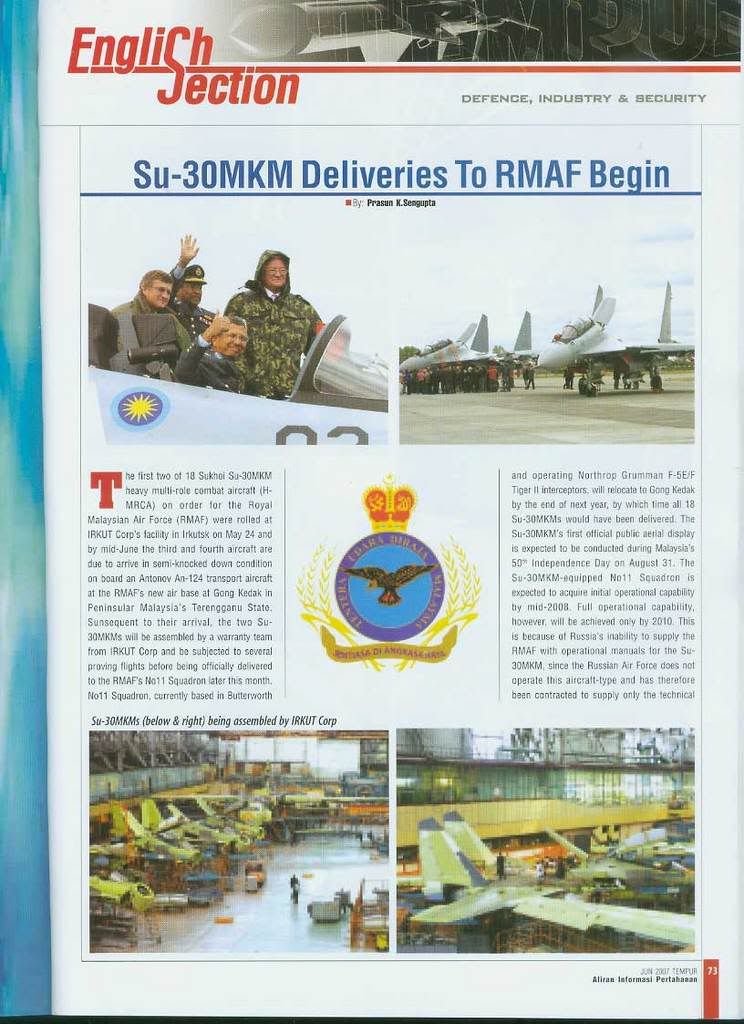
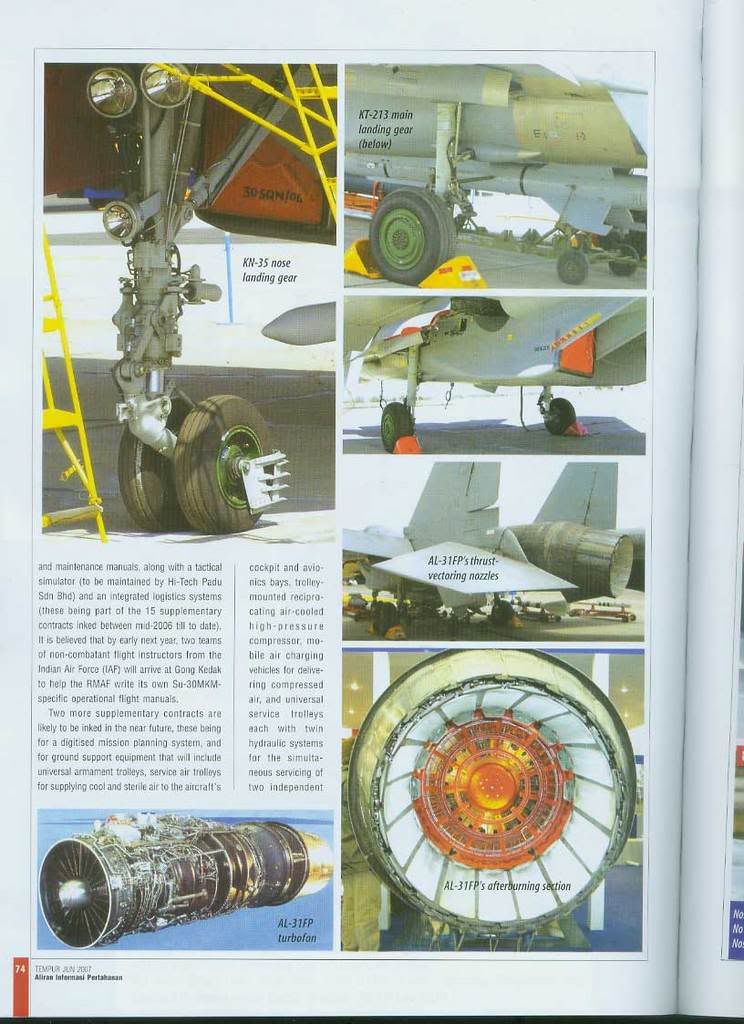
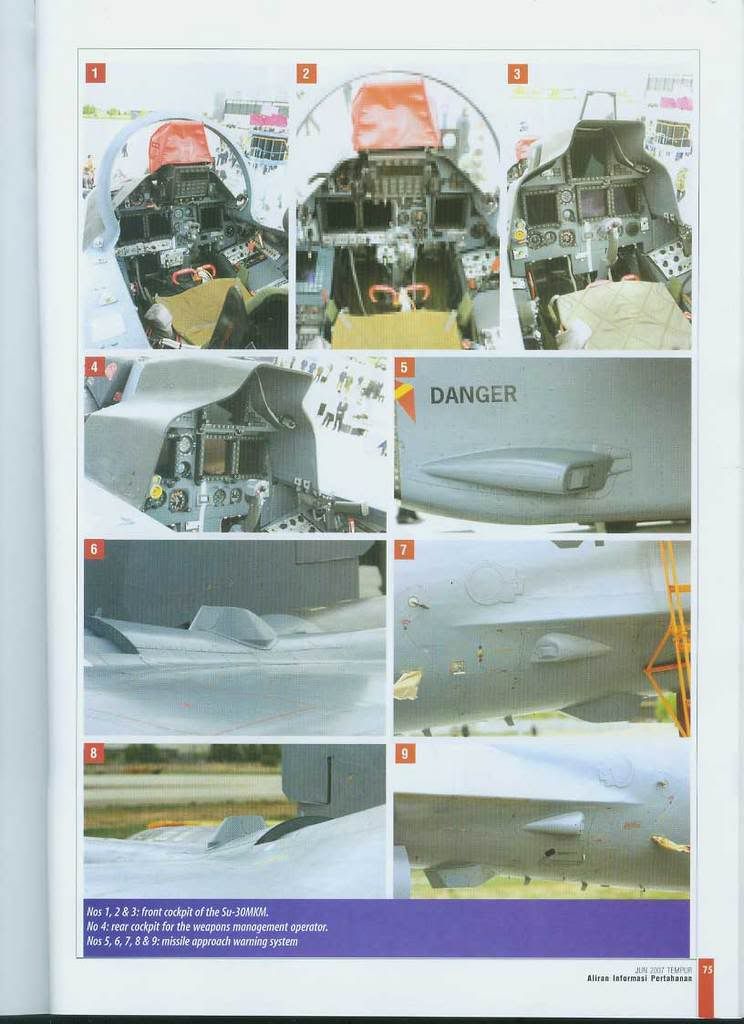
-
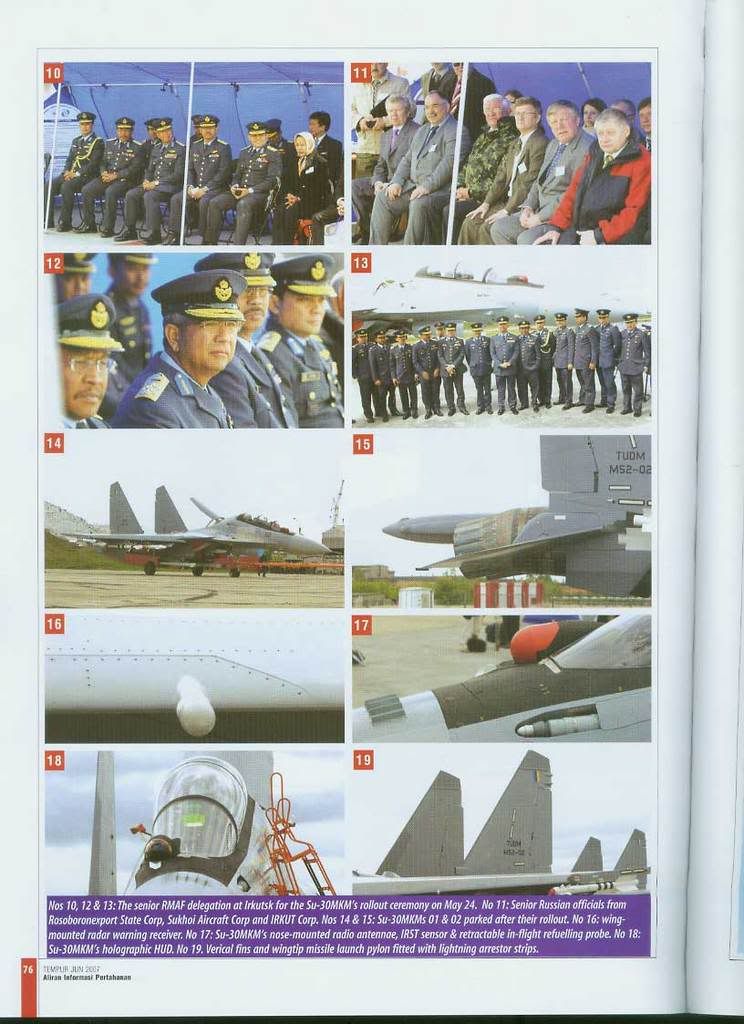
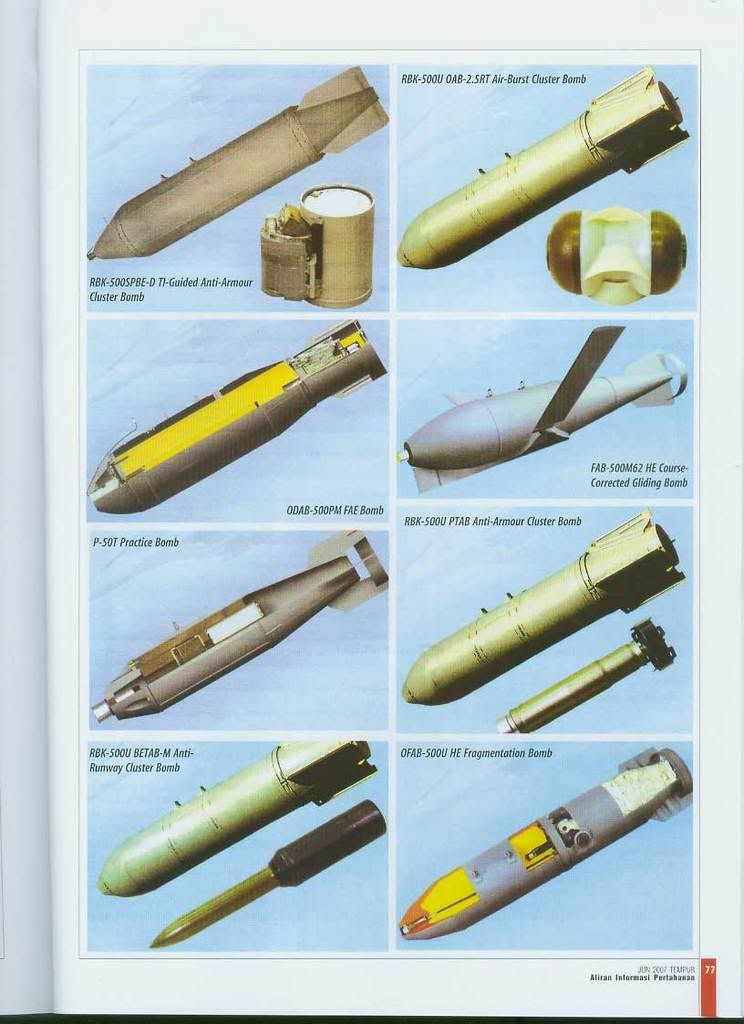
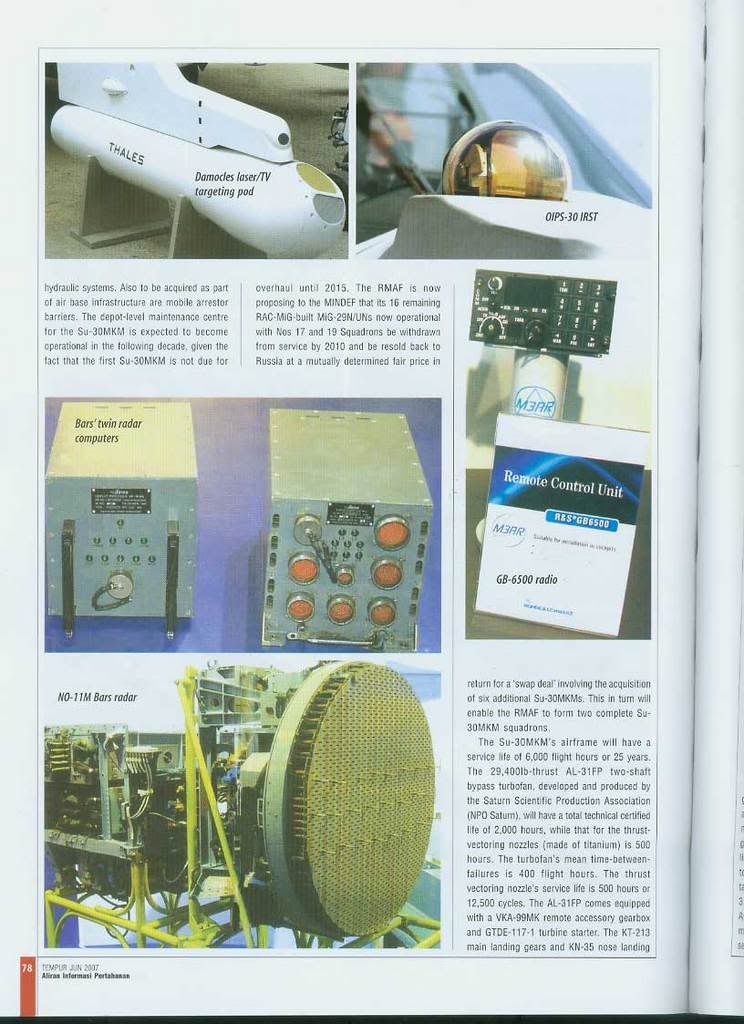
-
DAMN





-
Two Russian-made active jamming systems are located inside wing-tip containers,
Can I assume that is the Sorbitsya??
Perhaps the Malaysians have gotten a better deal that I first imagined. An effort by the Russians to swing against the prevalent American influence in our region? -
most probably.... or maybe a good candy for the indonesian who is eyeing to add more of the MK's..or the vietnamese....humongus potential deal, i tell you
-
Source: The Star Online
Friday August 10, 2007
Second batch of Sukhoi fighter jets expected next year
By MANJIT KAUR
SUBANG JAYA: The remaining 12 Sukhoi Su-30MKM fighter jets will arrive in the country by October next year to complement the existing six.
Deputy Prime Minister Datuk Seri Najib Tun Razak said the first batch of jets was received by Royal Malaysian Air Force (RMAF) chief Jen Tan Sri Azizan Ariffin on behalf of the Government in May at the Irkutsk Aircraft Corporation in Russia.
Najib, who is also the Defence Minister, said the Russian-designed aircraft equipped with state-of-the-art technology arrived at the operating air base at Gong Kedak that is situated at the border of Kelantan and Terengganu in mid-June.
"We hope to have the complete fleet by October next year,'' he said in his speech before the flight log book was handed to him by Rosoboronexport deputy director-general Victor Komardin, which later Najib handed over to Jen Azizan at RMAF Subang near here today.
Rosoboronexport is the Russian aircraft design and production agency.
Najib reiterated that the Government was not acquiring the assets because the nation's security was under threat, but because it was a continuing process of modernisation and a replacement programme for RMAF.
"The security environment in South-East Asia at the present and in the foreseeable future is expected to be stable and peaceful.
"In fact, the region has not seen a single major military conflict for more than 25 years,'' he said, adding that therefore the acquisition of the jets should not be perceived as an intention to build an offensive inexplicable weapons build-up in the region.
Najib said the superior, highly agile multi-role air fighter would also play an effective role as a strike and offensive capable aircraft, and that the acquisitions were a commitment to sustain and improve a well-balanced force.
"We want to ensure that RMAF is a balanced, versatile and credible force that will enhance the nation's defence capabilities,'' he added.
He added that the handing over of the jets marked once again the good bilateral relationship between Malaysia and Russia, which began with the delivery of the MIG-29N jet fighters in the 1990s.
Later at a press conference, Jen Azizan said currently there were four instructors flying the jets and the full squadron would be ready by the end of next year.
The Nukleus team chief Lt/Kol Muhamad Norazlan Aris when interviewed said the first batch of four pilots and two weapon sensor officers had undergone training in Russia, while the next batch of four pilots and two officers would be sent for similar training in India by November. -
Source: Bernama
August 10, 2007 16:22 PM
Najib: RMAF Must Fully Exploit Sukhoi Su-30MKM Capability
KUALA LUMPUR, Aug 10 (Bernama) -- The Royal Malaysian Air Force (RMAF) needs to utilise the state-of-the-art technology of the new multi-role combat aircraft, Sukhoi Su-30MKM, in enhancing its combat effectiveness and overcoming limited resources.
Deputy Prime Minister Datuk Seri Najib Tun Razak said the addition of this modern aircraft, a highly agile multi-role air fighter which could be effective as a strike and offensive capable aircraft, "augments the frontline combat capability of RMAF towards a balanced force development to enhance the national defence capability".
Najib, who is also Defence Minister, was speaking at the handing over of the Sukhoi Su-30MKM flight log book to him by Victor Komardin, the deputy director of Russia's Rosoboronexport, the manufacturer of Sukhoi, at the RMAF base in Subang, near here, Friday.
He said the handing over of the flight book signified another milestone in RMAF's modernisation programme to maintain combat capability.
"This is in line with the government's efforts to strike a reasonable balance between maintaining and sustaining the country's present capability and procuring new war fighting systems.
"What the RMAF lacks in size must be made up for with cutting-edge technological sophistication. Malaysia's new acquisitions are specifically a commitment to sustain and improve a well-balanced conventional force," he added.
Najib said the handing over of the Su-30MKM also marked continued good bilateral relations between Malaysia and Russia.
He said the cooperation that began with the MiG-29N deliveries in the 1990's which had now been supplemented by the Sukhoi aircraft with their greater range and powerful armament, was evidence of Russia's readiness to develop further cooperation with Malaysia, especially in the field of high technology.
In May 2003, Malaysia ordered 18 Sukhois at RM3.42 billion. Six of the aircraft had been received since June this year and are based at the RMAF base in Gong Kedak at the Kelantan-Terengganu border.
Meanwhile, RMAF chief Jen Tan Sri Azizan Ariffin said the Sukhoi squadron would be fully operational by the end of next year, and currently four pilots were undergoing training in Russia and more would be sent there after the first batch completed their course.
-- BERNAMA -
These birds will be fully combat ready only in 2010. That`s a long time. Now that `is' the official announcement. I am not confident at all that they will be fully combat ready in 2010 seeing as such that this is Malaysia. This purchase, like the Migs, will once again turn out to be a shoddy one. God knows how long they will really take.
-

5 degree 47.56N,102degree 29.04E
2007/06/21
11th Squadron gets first pair of Sukhois,By : Leslie Andres ,www.nst.com.my/KUALA LUMPUR: The Royal Malaysian Air ForceÂ’s latest squadron got its first aircraft on Tuesday when two Sukhoi Su-30MKM Flanker fighter jets were delivered.
The Russian-made aircraft were onboard an Antonov An-124-100 cargo aircraft, which landed at the Gong Kedak air base in Kelantan at 6.30pm.
An RMAF spokesman said two more aircraft were scheduled to arrive later this year.
The four will be on display at the Langkawi International Maritime and Aerospace exhibition in December.
The full squadron of 18 aircraft, procured in a deal estimated at US$900 million (RM3.08 billion), would be in operation by the end of next year.
The aircraft will form the RMAFÂ’s 11th Squadron, to be based in Gong Kedak, the air forceÂ’s newest base.
The delivery of the two aircraft came while Datuk Seri Abdullah Ahmad Badawi was in Moscow meeting with Russian President Vladimir Putin, on his first official visit to that country since becoming prime minister.
The aircraft were made at the Irkutsk aviation plant of the Irkut Corporation and are currently being assembled and inspected.
The two aircraft were formally handed over to RMAF chief Gen Tan Sri Azizan Ariffin in a roll-out ceremony at the plant earlier this year.
The Su-30MKM (an abbreviation which stands for modernised, commercial, Malaysia) is an advanced modification of the widely known multifunctional fighter jet, Su-30MKK.
However, the Malaysian version of the fighter jet significantly differs from the prototype in various systems.
Highly-manoeuvrable, the Su-30MKI version of the jet was also ordered by the Indian Air Force.
The aircraft will significantly beef up the RMAFÂ’s air defence capabilities as the squadron joins the existing fleet of Mikoyan-Gurevich MiG-29N Fulcrum, Boeing F/A-18D Hornet and BAE Systems Hawk 108 and 208 fighters.
The Fulcrums, like the Flankers, are made in Russia, while the Hornets and Hawks are American and British.
An RMAF crew with the Russian-made aircraft, which arrived at the Gong Kedak air base in Kelantan on Tuesday onboard an Antonov An-124-100 cargo aircraft. (Inset) The Sukhoi Su-30MKM Flanker fighter jet.